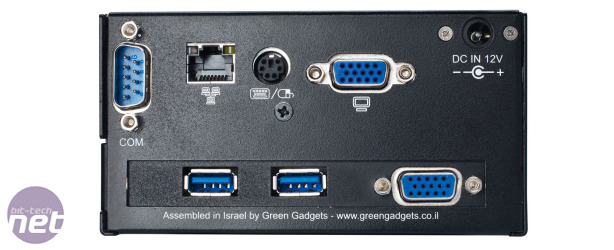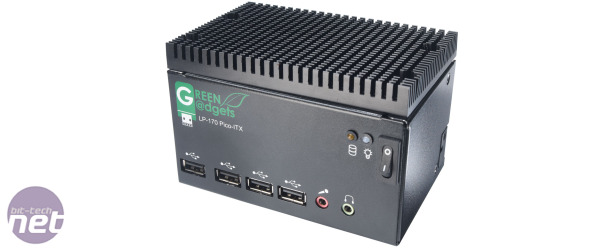
Green Gadgets LP-170 Pico-ITX Review
Manufacturer Green GadgetsUK Price (as reviewed) £418.80 (inc VAT)
EU Price (as reviewed) €350.00 (ex VAT, ex shipping)
It’s unlikely that you’ll have heard of Green Gadgets, as the company is a small Israeli start-up that specialises in – yes, you’ve guessed it – environmentally responsible PCs. This doesn’t mean that all the components are solar powered or made of recycled bike tyres, though; it simply means that the company produces a range of low-powered PCs that are designed to be tiny, efficient replacements for current desktop systems.
Interestingly, the company offers its low-power systems in two flavours: pre-built as a bare bones system in its own custom-made, passively cooled case (as in this review), or as an OEM component kit that doesn’t include the case. Confusingly, Green Gadgets merely calls its bare-bones system the LP-170 (the same name as the motherboard used), so when referring to the bare-bones system, we’ll call it the GG LP-170.
If you opt for the former version, the only parts you’ll need to add will be your own 2.5in hard disk or SSD and a single DDR2 SODIMM. If you buy the unit directly from Green Gadgets, you'll also need to add your own 12V power adaptor that outputs 3A as the company omits the power brick in order to lower postage costs and avoid many of the stringent import restrictions that countries impose regarding such items. However, the UK distributor Aleutia will ship the system with a power adaptor.
At the heart of the tiny system is the Pico-ITX Commell LP-170 motherboard. This tiny motherboard measures only 100mm x 72mm which, to put it into perspective, means that you could fit four Pico-ITX boards in the same area as a single mini-ITX board.
There's a 1.8GHz Intel Atom D525 processor soldered to the LP-170's PCB, which has an Intel GMA 3150 GPU located inside it. If the D525 doesn’t suit your needs then the motherboard is also available with other Atom chips embedded. The rest of the LP-170's PCB looks unusual, though, with no clearly labelled connectors to be seen. Instead, the board has so many bare headers that it looks like a bed of nails made for mice.
These connect to the large amount of outputs dotted around the exterior of the tiny box. There are four USB 2 ports, microphone and headphone jacks, a D-Sub output, a serial port, a LAN port and a single PS/2 port.
Meanwhile, Green Gadgets’ custom-built case is finished in an attractive matte black. The top of the case is covered in fins and makes contact with the CPU and Southbridge, which sit just below it, via a large copper contact plate. This moves heat into the top of the case to be emitted passively; as long as you fit an SSD rather than a hard disk, the GG LP-170 will be silent.

Our system came with two USB 3 ports and an extra D-Sub connection on the removable bracket, but you can pick and choose what you want here
Customisation options
Commell also makes a number of different mini-PCI-E cards for the LP-170 motherboard. These tiny cards can add almost any type of connection to the system, and there are brackets that fit into a vacant slot at the back of the case to provide the sockets for whichever connections the mini PCI-E card provides.The system we tested included a Commell MPX-7202 mini-PCI-E card to add two USB 3 ports and an additional D-sub connector, but it’s also possible to add dual Gigabit LAN sockets, dual FireWire ports, four serial ports or an 802.11b/g/n WiFi card and bracket. The Commell MPX-TP4R touchscreen controller module and the Broadcom BCM70015 HD video acceleration module are possibly the most interesting of those on offer, as these can radically change the way you use the PC.
These cards provide the option of building a relatively cheap touchscreen PC, and the GG LP-170 is so small that you could easily attach it to the back of a touch-screen display. The Broadcom card can turn the GG LP-170 into a tiny media PC capable of HD video playback that would be ideal for the living room. Inserting the card offloads the video decoding legwork from the CPU to the card, reducing CPU load during 1080p playback from around 70 per cent to about 15 per cent, and makes HD video playback a smoother experience.

MSI MPG Velox 100R Chassis Review
October 14 2021 | 15:04









Want to comment? Please log in.